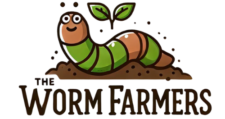Red Wigglers vs. Earthworms: What’s the Difference?
As a worm farmer, you may have heard about two common worms used for composting: red wigglers and earthworms. While both play an essential role in soil health and composting, some differences exist. This article will explore the similarities and differences between red wigglers vs. earthworms and help you decide which is best for your composting needs.
What Are Red Wigglers?
Red wigglers, or Eisenia fetida, commonly feature in vermicomposting systems. They are typically smaller than earthworms, measuring 2-3 inches long.
Red wigglers are voracious eaters and can consume up to half their body weight in organic matter daily.

Red wigglers can decompose organic materials and transform them into fertilizer-rich compost rapidly.
Thriving within a composting bin, red wigglers can break down a vast array of organic materials ranging from kitchen scraps and coffee grounds to yard waste.
Benefits Of Red Wigglers
One of the benefits of using red wigglers for composting is that they are relatively easy to manage. They require a moist, well-ventilated environment and a steady supply of organic matter to thrive. Red wigglers can transform your kitchen scraps into nutrient-rich compost, provided their basic requirements are met and nurtured well.
What Are Earthworms?
Earthworms, known as nightcrawlers or Lumbricus terrestris, frequently reside in the soil. They are larger than red wigglers, measuring 6-10 inches long.
Earthworms play an essential role in soil health, helping to aerate the soil and break down organic matter.

Earthworms possess the ability to enhance soil fertility and structure.
As they tunnel through the soil, they create channels for air and water to flow, which can help to improve soil aeration and drainage.
In addition, their castings (or waste) are rich in nutrients and can help to improve soil fertility.

Red Wigglers vs. Earthworms: The Differences
While both red wigglers and earthworms are essential for composting and soil health, there are some critical differences between the two:
Size: Red wigglers are more petite than earthworms, making them easier to manage in a composting bin.
Diet: Red wigglers are voracious eaters and can consume a wide range of organic matter, including kitchen scraps and garden waste. On the other hand, Earthworms prefer to eat decaying plant matter and soil.
Movement: Red wigglers are more active and tend to move around more than earthworms.
Red Wigglers vs. Earthworms: Which One Is Best for You?
When it comes to choosing between red wigglers and earthworms for composting, it depends on your specific needs.
Red wigglers are a great choice if you’re looking for a worm that can handle a wide range of organic matter and is easy to manage in a composting bin.
Earthworms are better if you’re more interested in improving soil health.
Red wigglers and earthworms are often used together in composting.
Red wigglers are great for quickly breaking down kitchen scraps and other organic materials. At the same time, earthworms can help to improve soil fertility and structure over time.
Are You A Beginner Worm Farmer?
If you’re new to composting, starting with red wigglers is a good idea. They are easy to manage and quickly turn your kitchen scraps into nutrient-rich compost.
As you gain more experience, you can experiment with adding earthworms to your composting system to improve soil health further.
It’s also important to consider the climate in your area when choosing between red wigglers and earthworms.
Red wigglers are more sensitive to temperature changes and may not survive in extremely cold or hot temperatures. On the other hand, Earthworms are hardier and can tolerate a broader range of temperatures.
Which Compost Worm To Buy?
When purchasing red wigglers or earthworms(Night Crawlers), buying them from a reputable source is essential. You can typically find them for sale online or at a local gardening store. Our favorite online retailer is Meme’s Worms.
Follow the seller’s instructions for introducing the worms to your composting system or garden.
Red Wigglers Vs. Earthworms Conclusion
Both red wigglers and earthworms are essential in composting and soil health. Red wigglers are great for breaking down organic matter quickly, while earthworms help to improve soil fertility and structure.
Depending on your specific needs and climate, you may use one or both types of worms in your composting system.
With some research and experimentation, you can find suitable worms to help you create nutrient-rich compost and improve soil health in your garden.







Pingback: Crafting the Best Worm Castings: Supercharge Your Garden -